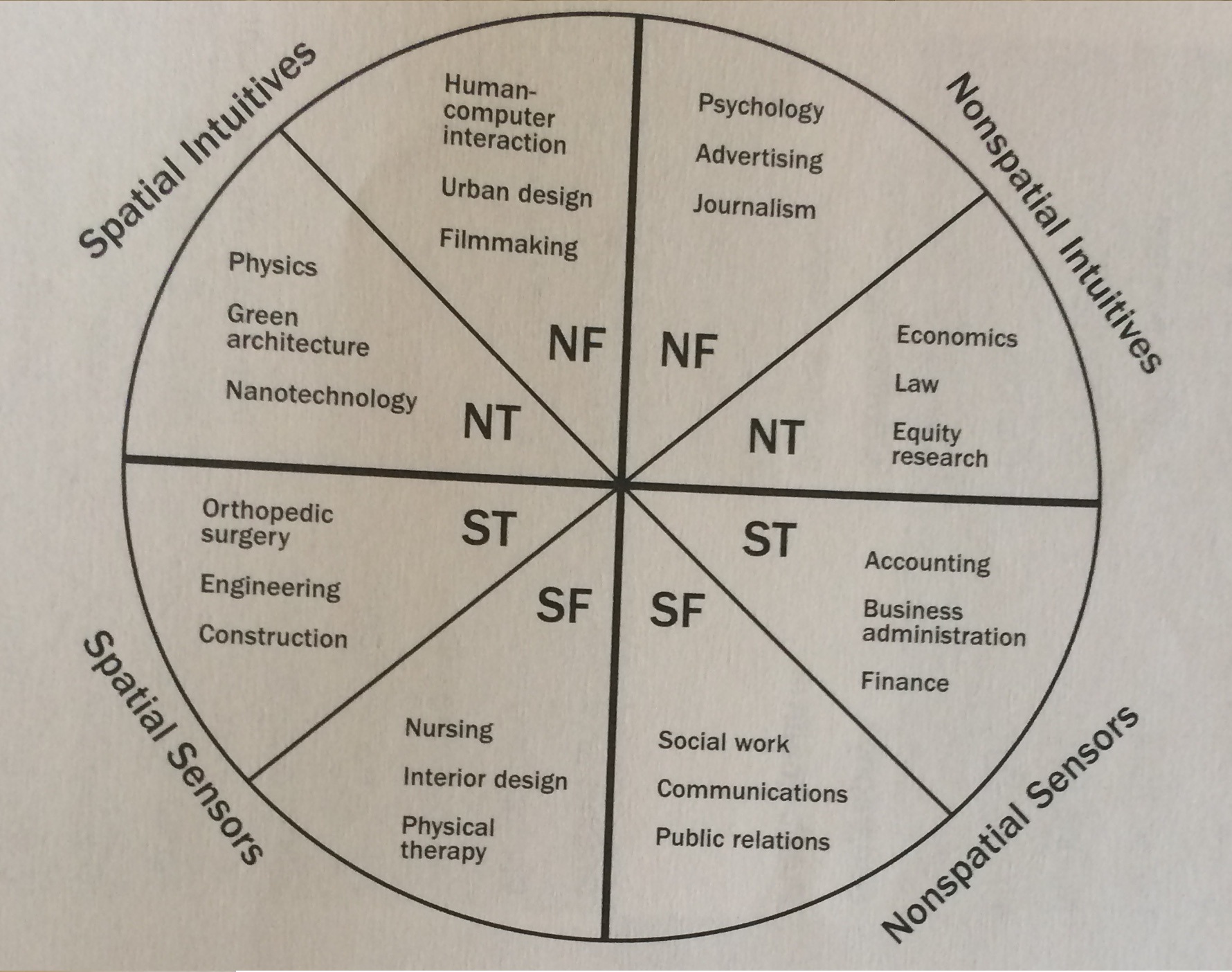The world is a big place. When choosing your career path, be sure you're headed in the I right general direction for your natural abilities. Clarifying a general direction will help you ask more useful questions. If you head east when your path lies west, you'll never get on the right road. I often hear people ask "Should I be a doctor or a lawyer?" as if those two careers lie in the same general direction. This question is a sure sign that the speaker isn't even on first base in getting to know him- or herself as a unique individual. It makes as much sense as asking "Should I teach Plato or design chairs for people with bad backs?"
For example, if you are spatial-oriented, you have an aptitude that "wants" to be constantly engaged in solving three-dimensional problems and situations. Many people who excel at spatial reasoning have mistakenly become lawyers. Law is a very nonspatial field, and most spatial people become very bored and unhappy in the legal profession because one of their strongest aptitudes is left high and dry all day long.
On the other side of the coin, a nonspatial-oriented person in a spatial career will find it difficult to excel and impossible to enjoy work. Surgeons who don't have spatial talent typically suffer from high stress caused by a constant fear of making mistakes. A lack of spatial talent creates a lack of confidence in their ability to visualize and work with 3-D anatomical problems. Here's a quote from Ben Carson, chief of pediatric neurosurgery at Johns Hopkins: "I became acutely aware of an unusual ability—a divine gift, I believe . . . encompassing the ability to understand physical relationships, to think in three dimensions. Good surgeons must understand the consequences of each action, for they're often not able to see what's happening on the other side of the area in which they're actually working. For some reason, do. Ho I am able to 'see' in three dimensions. . . . It's just something I happen to be able to do. However, many doctors don't have this natural ability, and some, including surgeons, never learn this skill. Those who don't [have this innate talent] don't develop into outstanding surgeons, frequently encountering problems, constantly fighting complications."

The left half of the pie consists of careers that require more tangible and spatial (3-D) orientation, and the right half consists of nonspatial, non-3-D orientation. The solid vertical line cuts the pie into spatial and nonspatial career fields. The horizontal dotted line cuts the career pie in half again; the top half is intuitive (N) and the bottom half is sensing (S). Each of the four quadrants represents a general career path direction.
You were introduced to these discrete talents and abilities earlier in this book. As a recap, the diagram below illustrates the two talent continuums, represented as pairs of op-posites. Recall your self-ratings in these areas; for example, if you lean toward spatial and intuition, this may predict your general career path to be spatial intuitive.
Spatial (3-D Objects) _____________________________ Nonspatial (Ideas)
Intuition (N) _________________________________________ Sensing (S)
THE FOUR GENERAL CAREER PATHS
Spatial intuitive (N). Physicists, geneticists, technology inventors, and filmmakers use the combination of spatial orientation and intuitive perception to imagine or invent spatial possibilities and solve complex systemic, three-dimensional problems. Together these abilities work as a talent for 3-D imagination, which is the aptitude toolkit for scientific discovery, technological innovation, spatial design, and creative problem solving in the physical world. People with this aptitude combination excel at designing and conceptualizing in 3-D and can work comfortably on projects with a long-term time frame, often on a global scale. Great inventors and physical scientists are members of this club.
Spatial 3-D imagination career fields: physical, earth, and life sciences Scientific research and development • Sustainable development and urban design
• Fine arts. design arts. film directing • Advanced technology innovation • Medical research
• Spatial sensor (S). Surgeons, occupational therapists, mechanics. craftspeople, and virtual real-ity programmers use the combination of spatial orientation a t 3-D and sensing perception for solving practical, concrete -D problems. people with this talent combination excel in the world of 3-D application, which is the aptitude toolkit for physically building tangible and useful objects and things in the immediate or near-term time frame. Great doctors and engineers are in this club.
Spatial 3-D application career fields: • Engineering and information technology • Acute and emergency medicine • Allied health care, nursing, physical therapy
• Construction, trades, and craftsmanship • Farming, agriculture, and forestry • Hairstyling
• Nonspatial intuitive (N). Economists, poets, psychologists, and historians use the combination of nonspatial orientation and intuitive perception for dreaming up new ideas, theories, and con-cepts to understand and solve complex social problems and situations. People with this talent combination excel in the career world of concept imagination, to include working imaginatively with ideas, data, knowledge, and information. Great novelists and visionary leaders are in this club.
Nonspatial concept imagination career fields: • Social sciences and humanities research ' Advertising and marketing research ' Creative writing, acting, documentary film • Law, geopolitics, international diplomacy • Journalism and publishing • Entrepreneurship and business strategy • Management consulting
Nonspatial sensor (S). Bankers, business executives, stockbrokers, and kindergarten teachers use the combination of nonspatial orientation and sensing perception for practically applying informations and concepts in the operation and administration of daily life in all types of organizations. People with this talent combination excel in the career world of information/ data
application, to include working practically with concepts, information, ideas, and knowledge. Great tax accountants and project managers are in this club.
Nonspatial data application career fields: • Business administration, sales • Public relations and communications • Accounting and finance • K-12 education • Social work • Operations research, statistics • Actuarial in science
MORE SPECIFIC CAREER PATHS
Recall your personality temperament (NF, NT, SF, or ST). In the illustration below, the career path pie chart incorporates temperament to create more specific career directions, eight in all.

In the left half of the career pie we now have four spatial career paths, and in the right half of the pie we now have four nonspatial career paths.
Spatial Career Paths Nonspatial Career Paths
Spatial NF Spatial NT Nonspatial NF Nonspatial NT
Spatial SF Spatial ST Nonspatial SF Nonspatial ST
The detailed pie chart on the next page illustrates a few example subject areas for each slice of the career pizza pie.
If you find more than one segment of the circle that describes you, that's fine. Many people are a mix of these descriptions. For example, someone with an SF temperament who is in the middle of the spatial-to-nonspatial continuum, also called "tangible," may find suitable career fields in both the spatial SF and nonspatial SF general areas.

Click here to take a Career Assessment Test to know your Perfect Career Match.



Leave a Comment
To post comment, please